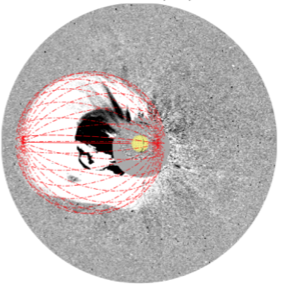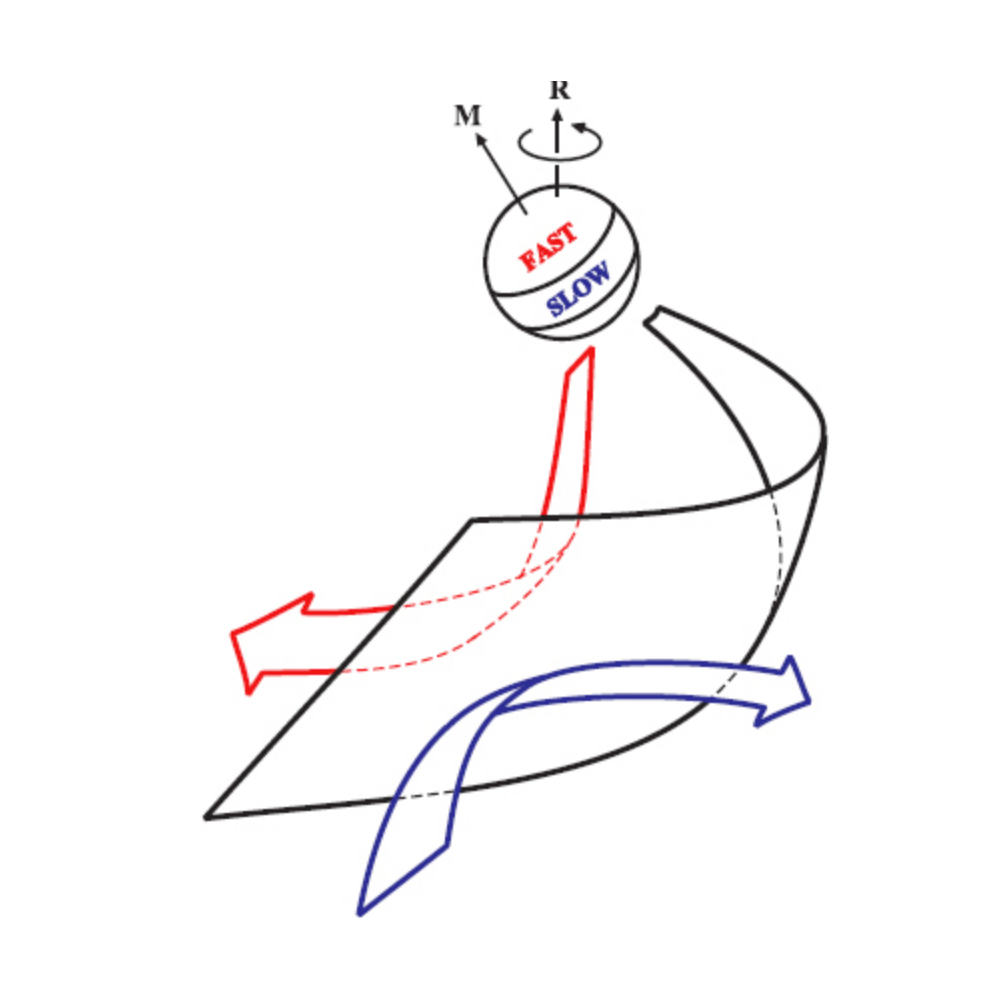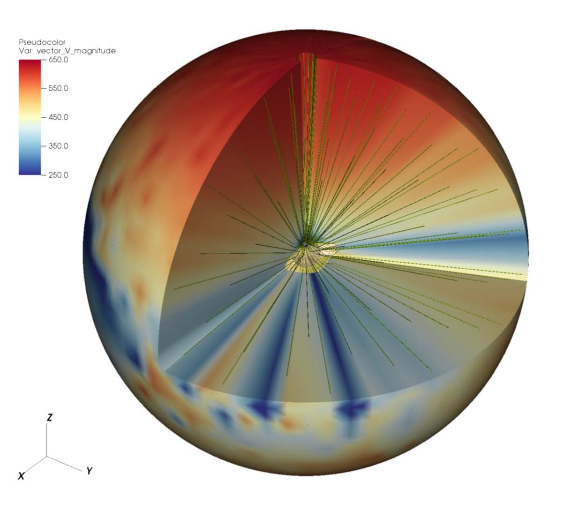STORMS produces advanced catalogues of solar/heliospheric structures. The production of these catalogues is based on the detailed analysis of remote-sensing observations and in situ data. They can involve multi-point imaging to derive the 3-D structure of solar wind structures. They can also be produced from the output of simulations of the solar corona and solar wind.
CME
Catalogue of 3D Shock Waves
To test the shock hypothesis as the prime particle accelerator in the heliosphere, it is essential the further development and the application of novel methods to determine the shock wave dynamics during solar eruptive events. We exploit coronal imagery in different vantage points and wavelengths to locate and map the time varying 3-D expansion of pressure waves and derive their magneto-plasma properties including: the velocity, Mach numbers, compression ratios and geometry in 3-D. Our methods, _that constitute the current state-of-the-art_, reside in forward shock modeling techniques using nearly simultaneous multi-viewpoint white light and EUV observations of pressure/shock waves combined with background coronal and solar wind MHD models to deduce the critical shock parameters in 3-D. The application of the developed tools and methods during COROSHOCK project allow us to perform:
- Detailed 3-D reconstructions and modeling of coronal shock waves.
- Detailed coupling of the shock wave modelling with magnetic connectivity to evaluate the shock impact on specific regions of the inner heliosphere.
- Detailed analysis of the 3D shock wave properties and connection to SEP and γ-ray events properties.
- [Under-development] The construction of catalog of 3-D reconstructed and modeled shock waves for a plethora of eruptive events.

SOLAR CORONA
Catalogue of CIRs
The systematic monitoring of the solar wind in high-cadence and high-resolution heliospheric images taken by the Solar-Terrestrial Relation Observatory (STEREO) spacecraft permits the study of the spatial and temporal evolution of variable solar wind flows from the Sun out to 1 AU, and beyond. To track individual features as they propagate through the fields of view of the heliospheric imagers, maps of brightness variation are often created by extracting bands of pixels along a constant position angle (PA), corresponding to a fixed solar radial, and displaying them as a function of elongation (Y-axis) and time (X-axis). Such time–elongation maps are often referred to as J-maps (Sheeley et al., 1999, 2008a,b; Davies et al., 2009).

We have derived the spatial-temporal evolution of each of these corotating interaction regions ((CIRs; reviewed in, e.g., Owens & Forsyth 2013) ) by using a well-established fitting technique. As part of the EU Framework 7 (FP7) Heliospheric Cataloguing, Analysis and Techniques Service (HELCATS) project, we have generated a catalog listing the properties CIRs well-observed in images taken by the Heliospheric Imager (HI) instruments onboard STEREO-A and STEREO-B between 2007 and 2014. This catalogue provides:
- A publicly available list of CIRs/SIRs observed in Heliospheric Imaging from April 2007 to September 2014 (more than 200 events). Available through HELCATS website or interactively through the Propagation Tool. User-defined fitting can be also performed instead of the provided fit.
- Corresponding mean velocity of each structure, origin point on the solar surface, and predicted impact times at different vantage points in the inner heliosphere.
- Possibility to directly compare the predicted impact time with in-situ measurement, through the interface of the Propagation Tool with AMDA database.
- Detailed list of individual blobs for one representative case. Study presented in Sanchez-Diaz et al, 2017. Fiiting data of blobs available on demand.
- REFERENCES
- Plotnikov et al, Solar Physics, Volume 291, Issue 6, pp.1853-1875 (2016)
- Sanchez-Diaz et al, Astrophysical Journal Letters, Volume 835, Issue 1, article id. L7, 7 pp. (2017)
- Sanchez-Diaz et al, Astrophysical Journal, Volume 851, Issue 1, article id. 32, 17 pp. (2017)
- Sanchez-Diaz et al, Astrophysical Journal, Volume 852, Issue 1, article id. 51, 11 pp. (2019)
SOLAR WIND
Catalogue of Multi-VP Simulations
We account for the physical processes known to operate in the corona and in the interplanetary medium during the acceleration and transport of particles. The production of high-energy particles at the shock will be parameterized using the magneto-plasma shock parameters that are deduced from the 3-D reconstructions and modeling. The result of this parameterization will produce a time varying spectrum of particles at the shock. In addition, we will account for particle transport mechanisms in the interplanetary medium by developing a 3-D particle transport model based on the solution of stochastic differential equations to model the random walk of energetic particles during their propagation to 1AU. This approach is computationally tractable and much simpler to implement numerically than the solution of the full Parker transport equation using finite-difference schemes.

From the application of the acceleration and transport models to the modeled shock waves we will:
- Parameterise the particle energisation and modell particle propagation from the shock to the solar surface to explain the properties of the long-duration >100 MeV γ-ray events.
- Be able to study the longitudinal variability of SEPs through the coupled shock wave and particle transport modeling.
- Exploit the possibility to convert the flux of energetic particles into electromagnetic radiation to produce synthetic γ-ray, hard X-ray, and radio fluxes during highly energetic eruptive events.
CME
Catalogue of SEP simulations
This catalogue of simulated SEPs was produced by a collaboration between the universities of Barcelona, Turku, Leuven and Toulouse during the EUHFORIA 2.0 project. The focus was set on gradual SEP events, which are produced by shock waves driven by coronal mass ejections (CMEs) and are most problematic from a space-weather perspective. The overall SEP modelling procedure can be summarised as follows:
- Computation of the ellipsoidal shock location vs. time by matching the observed time of arrival at Earth
- Derivation of the evolution in time of the shock parameters at the cobpoint, which is the point at the shock magnetically connected with the observer
- Computation of the particle emission rate Q at the cobpoint by fitting of the observed intensities with the Shock and Particle (SaP) transport code (Lario et al. 1998; Aran et al. 2007)
- Derivation of the QVR-relations by using the particle source function, Q (from SaP), and the VR parameter (from the ellipsoidal shock) at the cobpoint
- Use of the QVR-relations as input source to PARADISE, which is run for the ellipsoidal shock propagated through the coronal plasma modelled by MAST and through the solar wind modelled by EUHFORIA
HELP
OBJECTIVES
One of the goals of the EUHFORIA 2.0 project is to integrate simulation models of the solar energetic particle (SEP) acceleration and transport into the MHD model of the solar wind EUHFORIA. The focus is given to gradual SEP events, which are produced by shock waves driven by coronal mass ejections (CMEs) and are the most important from the space weather perspective. In EUHFORIA 2.0 being directed to the development of space weather prediction tools, the following requirements were imposed on the SEP models: (i) to show that the SEP onset time in the simulations falls into the ±12 h-window relative to the observed onset time, and (ii) to show that, if the observed peak integral flux of >10 MeV protons exceeds the threshold value of 10 pfu, it does so in the simulations.
SEP MODEL
In the project, the above specified requirements were met when simulating SEP events using a QVRPARADISE model. This is a coupled model consisting of the semi-empirical model of the SEP source at a shock (which is based on the semi-empirical relation between the particle emission rate Q and the normalised plasma speed ratio VR of the shock (Heras et al. 1995; Lario et al. 1998; Aran et al. 2006, 2007; Pomoell et al. 2015)) and the particle transport model PARADISE (Wijsen 2020).
SHOCK MODEL
Modelling of the particle source at travelling shocks and the subsequent particle transport requires a model of a shock propagating from the corona to the observer (in our case, satellites orbiting near the Earth). Since self-consistent coronal CME models are currently computationally intensive, we resorted to the semi-empirical coronal shock model (Rouillard et al. 2016; Kouloumvakos et al. 2019), which is based on fitting the white-light coronagraph images of CMEs by using ellipsoids. The coronal shock parameters in this model were computed using the MAST model of the corona (Lionello et al. 2009). In order to avoid possible gaps and discontinuities in the shock parameters at the lower boundary of EUHFORIA (Pomoell & Poedts 2018) simulation domain, at r = 0.1 au, we extrapolated the ellipsoidal shock kinematics from < 0.1 au to 1 au, assuming that the shock expands self-similarly and making sure that the simulated shock arrives at Earth at the same time as the interplanetary shock in the corresponding observation. Then we propagated the ellipsoidal shock in the EUHFORIA simulation domain, i.e., through the EUHFORIAsimulated solar wind.




